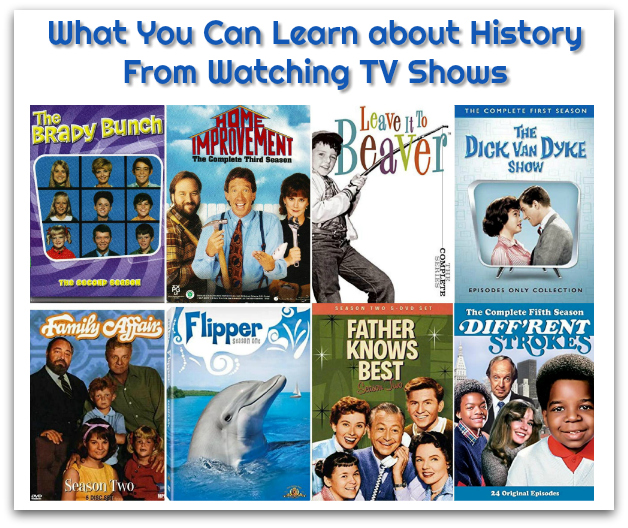“So what did you notice about the older TV shows compared to the more recent TV shows?” I asked a roomful of homeschool kids. We had just finished watching 2 TV sitcoms from the 1950s to the 1980s.
I expected to hear about the funny hairstyles, fashion, family values, or furniture. I was surprised when I got my answers.
“They were so polite to each other.”
“Everyone was kind in the older shows.”
“In the latest shows, the people didn’t have good manners.”
I hadn’t realized how much politeness and kindness had disappeared from TV shows, but the children did. We went on from there to talk about fashion, values, and political statements. I was surprised at how much the kids learned that day about life and how life changed in the second half of the 20th Century.

Revealing Culture
TV shows give us a glimpse at daily life in a unique way.
The sets reveal architecture and furniture that is popular at the time the show is made. The hair styles and fashion are evident for viewers to observe right away.
Pretend we are learning about the Space Race in history class. I might show an episode of I Dream of Jeannie which is set in Cocoa Beach near Cape Kennedy Space Center. The sitcom ran from 1965-1970. It’s a silly show but there are astronauts, fashions, and made-up situations that are straight from the 1960s. It is a great way to travel back in time to the Space Race. It is a more genuine way to get a feel from the culture than a book written today or a movie produced in modern times set in the 1960s.
Politics & Values
In addition, values are portrayed in subtle and not-so-subtle ways. Sometimes, the story line cheers on a political issue like feminism (girls can do anything that boys can in Brady Bunch) or cold war (evil Russian spies in Scarecrow and Mrs. King). Sometimes characters share their views openly. In All In The Family, Archie is made to look bigoted and stupid, a slam at conservative working class folks. Anti-war sentiment is openly discussed by Hawkeye and the other characters in MASH.
In some shows, people who live in the country are made out to be buffoons (Green Acres). In the old Get Smart comedy, the Cold War is mocked.
Travel Through Time
When we study 20th Century history, we always have a couch potato day where we start in the 1950s and move through time to the 1990s.
We chose 1-2 sitcoms from each decade, but you could also do this with cops shows, mysteries, dramas, or variety shows.
After each show, we talk briefly about what we liked and didn’t like. We also list the things unique related to the culture of the decade.

Here are some of the shows we’ve watched over the years.
1950s:
- Father Knows Best
- Leave It to Beaver
- I Love Lucy
1960s:
- Dick Van Dyke Show
- Flipper
- Family Affair
1970s:
- Brady Bunch
- Good Times
- The Bob Newhart Show
1980s:
- Family Ties
- Different Strokes
- Full House
1990s:
- Home Improvement
- The Wonder Years
- Everybody Loves Raymond
Until next time, Happy Homeschooling!
Warmly,
Meredith Curtis
—oOo—
Meredith Curtis, homeschooling mom, writer, speaker, and publisher, loves to encourage families in their homeschooling adventure. She is the author of Travel God’s World Geography, Travel God’s World Cookbook, and HIS Story of the 20th Century. You can check out her books, curricula, unit studies, and Bible studies at PowerlineProd.com. Free Reading Lists for all ages are available at JSHomeschooling.com. Read her blogs at and PowerlineProd.com and listen to her at Finish Well Radio


I love this idea! My son was watching The Andy Griffith show with us last night and loved it.